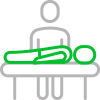Chiropractic
First, a little Anatomy 101!
A joint is the meeting of two bones. These are united by a watertight joint capsule that contains a viscous liquid: the synovium. In the human body, there are large joints, such as the knee and smaller joints such as the fingers. At the level of the spinal column, the front of the vertebrae articulates together through a disk which in fact acts as a shock absorber. When there is too much pressure on the intervertebral disc, it can spread out and cause a condition called disc herniation. As for its posterior part, the vertebrae articulate with each other through small bony areas called articular facets. If they become irritated, they can cause a condition called facet syndrome. Several studies show that chiropractic is very effective for treating these two conditions in addition to a multitude of others.
The muscles are responsible for the movement of the human body because of their contractile ability (to shorten). They attach to the bones through both ends called tendons. Muscle usually crosses a joint and therefore assures its movement. What causes the contraction of a muscle, and thus the movement of a joint? The answer is nerve conduction. In simple terms, it is an electrical impulse that emerges from the brain. It then travels in a large wire called the spinal cord through the spine to eventually reach the muscle through a nerve exiting between two vertebrae. When the nerve conduction arrives to the muscle, it causes its contraction. Unfortunately, the nerve can get entrapped on its path by a misaligned bone, a tight muscle or even a herniated disc. Chiropractic is also effective to treat these pinched nerve conditions, like carpal tunnel syndrome for example.
Chiropractic exam
Chiropractic is a health care profession which aims to detect, correct and prevent neuro (nerves) musculo (muscles) skeletal (joints) malfunctions. A subluxation is present when one or two bones forming a joint are slightly misaligned or there is reduction of the normal joint movement. With a highly accurate exam, the chiropractor is able to detect subluxations and treat them using a specialized type of manipulations called chiropractic adjustments.
Chiropractic treatment: Do I have to get ‘cracked’?
No! There are two types of manipulation which are, in my opinion, as effective.

The first type that I often use in my clinic is based on speed and is done with a tool that resembles a little punch called the activator. It allows me to make vertebral and limb corrections using a fast, very gentle impulse without cavitation (cracking).

The second type of manipulation is rather based on depth. By stretching the joint capsule filled with fluid (synovium), it causes an audible gas release. This process is called cavitation.

In addition to correcting joint subluxations, the chiropractor is also trained to carefully examine and treat the musculature. Exercise and lifestyle recommendations are another important aspect of chiropractic treatment. The chiropractic approach is as much preventive as curative.
The chiropractic profession
To practice chiropractic in Quebec, all chiropractors must have successfully completed their university undergraduate chiropractic doctoral degree. They then have to pass national examinations of the Canadian Chiropractic Examining Board, as well as a review on the legislation and ethics exam of the Ordre des chiropraticiens du Quebec (OCQ). The main mission of the OCQ is to ensure the protection of the public. To do this, the OCQ establishes standards of practice that more than 1,200 Chiropractic doctors must meet in Quebec.
My mission is to treat my patients how I would like myself to be treated. I strive for maximum patient satisfaction so that every referral is well-earned.



